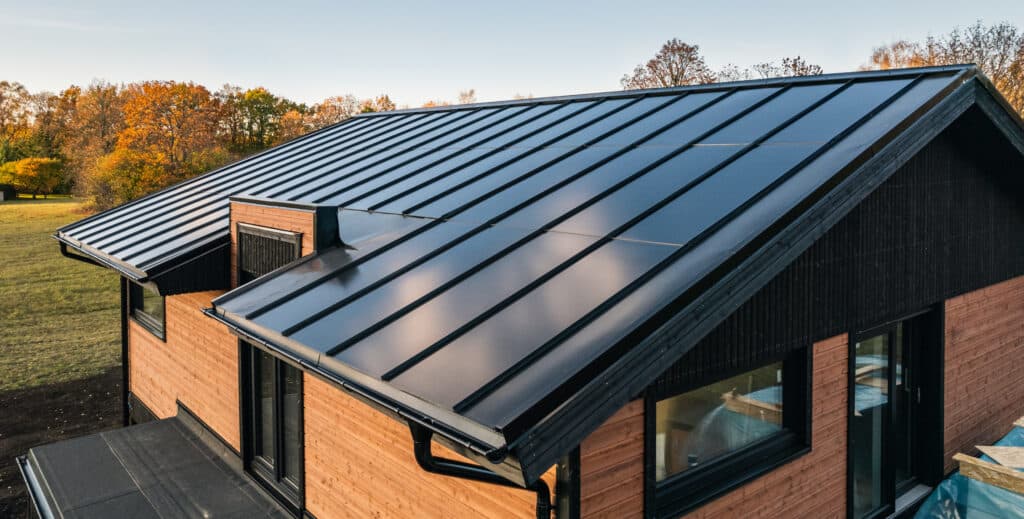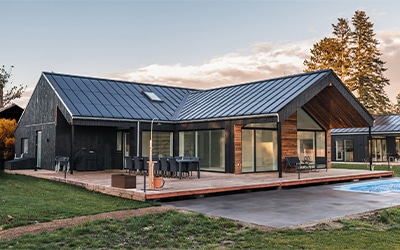Solar roof tiles, or solar power tiles, are quickly becoming a popular renewable energy option in the UK. Designed to integrate into a home’s roof, these tiles offer a more attractive alternative to traditional solar panels.
Whilst they’re great for sustainability, are they worth the investment for UK homeowners? Let’s explore the benefits, costs, and practical considerations to help you decide.
What Are Solar Roof Tiles?
Solar roof tiles are innovative energy solutions that function like solar panels while doubling as roofing material. Unlike bulky solar panels, these tiles blend with your existing roof to maintain your home’s appearance.
The discreet nature of solar roof tiles makes them optimal for UK homeowners looking to preserve their property’s traditional appearance. Whether you’re struggling with strict planning regulations, conservation zones or living in a traditional town, they provide a discrete and efficient way to generate solar energy.
How Do Solar Roof Tiles Work?
Solar roof tiles are made from photovoltaic (PV) materials, just like traditional solar panels. These materials capture sunlight and convert it into electricity that can power your home. The electricity is typically stored in a solar battery system or fed directly into the national grid.
Understanding the Key Components
Though the process of solar systems may seem complex, here are the key elements:
Photovoltaic cells: These are embedded within the tiles to absorb sunlight, which will then be converted into a useful electricity.
Inverter systems: Convert the DC (direct current) electricity generated into usable AC (alternating current) electricity.
Battery storage: Ensures excess energy can be stored for use during cloudy days or at night.
Pros and Cons of Solar Roof Tiles
Advantages of Solar Roof Tiles:
Aesthetic Appeal:
Solar tiles are designed to mimic traditional roof materials, maintaining the architectural integrity of your home and avoiding what some may view as an ‘eyesore’.
Solar roof tiles give those people who don’t like the look of traditional solar panels the opportunity to generate their own power and/or offset their carbon footprint.
Space Efficiency:
As the tiles double as roofing and energy-generating components, they’re a versatile choice even for homes with limited roof space.
Durability:
Solar roof tiles are built to withstand harsh weather conditions, including wind, rain, and hail. No matter how dramatic the weather in the UK is, solar tiles can withstand it.
Long-term Savings:
While the initial cost is high, reduced energy bills and potential earnings from exporting energy to the grid can offset the investment. Particularly with the ever rising costs of electricity bills in the UK.
Disadvantages of Solar Roof Tiles:
Higher Initial Costs:
Solar tiles typically cost more than traditional solar panels, making them a significant upfront investment. If you don’t truly value the aesthetic appeal, the additional cost up front may not be worth it.
Lower Efficiency:
Although the difference is minor, and is constantly improving, solar tiles sometimes have slightly lower energy efficiency than standard solar panels.
Specialised Installation:
Fewer installers are experienced in fitting solar roof tiles, meaning that it can be more difficult to choose the right company for you. Thankfully, Smartly Energy are well adverse in fitting solar roof tiles in the UK, so you need look no further.
Costs of Solar Roof Tiles in the UK
The cost of solar tiles can range from £15,000 to £30,000 for an average UK home, depending on the size of the roof and the type of tiles selected. By comparison, traditional solar panels cost between £5,000 and £8,000.
Financial Incentives:
UK homeowners may benefit from energy provider schemes which reward surplus energy being fed back into the grid. Octopus Energy for example have ‘Outgoing Octopus’, in which homeowners earn 15p/kWh of energy that is fed back into the grid.
Efficiency and Performance
While solar roof tiles have a lower efficiency rate than traditional panels (averaging 10-20% compared to 15-22%), they are improving rapidly. Factors affecting their performance include:
Roof orientation: South-facing roofs maximise sunlight exposure, so this is something to keep in mind when considering your home for solar tiles.
Shading: Nearby trees or buildings may reduce energy output; homes with solar power tiles produce more energy in open areas.
UK climate: Despite the cloudy weather, solar technology can still generate power from indirect sunlight. So, take it from us, UK weather doesn’t ruin everything.
For larger homes with ample roof space, traditional solar panels may be a better option due to their higher efficiency and lower cost per watt. However, smaller homes or properties where aesthetics play a critical role, such as listed buildings, may find solar tiles more advantageous.
Installation Considerations
Roof Compatibility:
Not all roof types are suitable for solar tiles. Ideally, roofs should have a pitch of 15-45 degrees and minimal shading. Larger roofs may benefit more from traditional solar panels as they can accommodate more PV cells, providing a higher overall energy output.
Planning Permissions:
In most cases, solar tiles are considered permitted development. However, listed buildings or properties in conservation areas may require planning approval. This is something you will have to take into account for both solar panels and solar tiles. Find out more here about planning permission.
Certified Installers:
Hiring experienced professionals is crucial. Look for companies accredited by the Microgeneration Certification Scheme (MCS), such as Smartly Energy.
When to Choose Solar Tiles vs. Solar Panels
Choose Solar Tiles If:
- Aesthetic integration is a high priority.
- Your property is in a conservation area or listed building, or an area that simply ‘may not approve’ of traditional panels.
- Roof space is limited, and you prefer dual-functionality roofing.
Choose Solar Panels If:
Solar panels are a more traditional alternative to solar roof tiles, you can find out more about them here.
- You have a larger roof area that can accommodate more panels, as this could be extremely costly for solar tiles.
- Maximum energy efficiency and cost-effectiveness are your goals; solar panels are slightly cheaper and more energy efficient.
- Upfront costs are a concern, as solar panels are more affordable.
For example, a detached four-bedroom house with a large south-facing roof might achieve better energy output and savings with traditional solar panels. On the other hand, a small cottage in a conservation area may benefit more from the discreet design of solar roof tiles.
Environmental Impact
Solar roof tiles contribute to reducing carbon emissions and reliance on fossil fuels. According to the UK government, a typical solar installation can save approximately 1.3 to 1.6 tonnes of CO2 annually.
Furthermore, many Solar Energy companies have additional processes to contribute to sustainability and a decreased carbon footprint. Opting for a certified Carbon Neutral Business like Smartly Energy is a great way to ensure that your investment has minimal negative environmental impact.
Conclusion
Solar roof tiles in the UK are a viable option for homeowners seeking a sleek, eco-friendly energy solution. Although they come with higher upfront costs and slightly lower efficiency compared to solar panels, their aesthetic appeal and dual functionality make them an attractive investment for those prioritising design and sustainability.
If you’re considering solar roof tiles, assess your roof’s compatibility, calculate potential savings, and explore government incentives. For larger properties or those with straightforward installation needs, traditional solar panels may still offer better value for money.
With the right installation, solar tiles can be a worthwhile investment for your home and the planet. Looking for more info? Contact us today.
FAQs
What is the lifespan of solar roof tiles?
Most solar tiles come with warranties of 25-30 years, similar to traditional solar panels.
Can solar roof tiles be installed on any roof?
While they suit most roof types, flat or highly shaded roofs may require additional modifications.
Are solar roof tiles suitable for listed buildings?
Special permissions may be required for listed buildings or properties in conservation areas.
How much electricity can solar roof tiles generate in the UK?
Depending on roof size and orientation, they can generate between 2,000 and 4,000 kWh annually.



